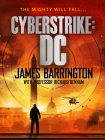Cyberstrike, James Barrington [short story to read .TXT] 📗

- Author: James Barrington
Book online «Cyberstrike, James Barrington [short story to read .TXT] 📗». Author James Barrington
Independence Day and the Declaration of Independence
On 4 July 1776 the Declaration of Independence was adopted by the Second Continental Congress, the fledgling government of the thirteen colonies that made up the fledgling nation. In what was then legally an act of treason, the Declaration permanently broke the ties between America and Great Britain and established the country as a free and independent nation, no longer subordinate to or a subject of the British monarch.
The American Revolutionary War, also known as the American War of Independence, had started in April the previous year, and the preparation and signing of the Declaration did nothing to end the hostilities: the tide only turned decisively against the British with their defeat at the end of the Siege of Yorktown in October 1781, and the final peace accord, the Treaty of Paris, wasn’t signed until September 1783.
In point of fact, Americans actually celebrate the wrong date: the decision to declare independence had been voted on and passed by Congress two days earlier, on 2 July, but the Declaration itself was not made until 4 July 1776. And it’s almost certain that not all the members of Congress signed the document on 4 July, or indeed at any time that month: it’s far more likely that many of the fifty-six delegates only put pen to paper as much as a month later, on 2 August.
The morning of 4 July 1777 was marked by a thirteen-gun salute – one for each of the thirteen colonies – at Bristol in Rhode Island, a celebration repeated as dusk fell that evening. Ever since then Independence Day has been celebrated across America. Interestingly, it wasn’t until 1870, almost a century after the Declaration of Independence, that the date became a holiday for federal employees – unpaid, of course. They had to wait for another sixty-eight years, until 1938, for it to become a paid holiday.
Unmanned Aerial Vehicles (UAVs) or drones
One of the defining characteristics of warfare in the first two decades of the twenty-first century has been the increasing reliance upon RPAs and UAVs – remotely piloted aircraft and unmanned aerial vehicles – of various types, ranging from intelligence-gathering platforms to armed devices the size of a small aircraft, all types now universally known as drones. And it’s not difficult to see why.
Drones cost much less than a military aircraft designed to do the same job and can be both lighter and have a far longer endurance than a conventional aircraft, largely because they’re not having to lug around the deadweight of the pilot or pilots in the cockpit. And, if something catastrophic happens in the air or the drone is hit by a missile or anti-aircraft fire, the end result is a smallish crater on the ground filled with torn and twisted aluminium but, crucially, no living pilot to be captured and paraded in front of the world’s press. Or, if the ground troops are a part of ISIS, to be doused in petrol and then burnt alive in front of a flock of video cameras and a crowd of radical Islamic thugs baying for blood.
These days, people are familiar with the occasional image on the evening news showing the aftermath of a drone strike – a new word that has now entered the vocabulary of the English language – that has targeted a wanted terrorist in a remote area of the Middle East where conventional forces would find it extremely difficult or impossible to operate. Such attacks typically involve a Hellfire missile fired from a drone known as a Reaper, an extremely efficient airborne killing machine that frankly does its job much more effectively than any pilot in a manned aircraft could ever do.
What many people don’t realise is that although drones like the MQ-1 Predator and the MQ-9 Reaper are unmanned, they do have a man at the controls, a trained military pilot usually sitting in an air-conditioned bunker on an air base in Nevada or Montana, half a world away from the scene of the action, who communicates with the UAV through satellite links and who can see what is in front of or below the drone through high-resolution camera systems. It is almost as if the pilot is actually in the aircraft, but without the inherent danger that his physical presence would pose.
The figures are unambiguous. How long a UAV can remain in the air is largely determined by its weapons fit, and the Reaper can carry a maximum payload of 3,750 pounds of munitions, primarily a mix of Hellfire missiles and GBU-12 and GBU-30 bombs. With a full fuel load and that payload the Reaper’s radius of action is 1,150 miles and it can stay aloft for between sixteen and twenty hours. Some drones are now achieving airborne endurance times in excess of forty hours. To manage anything like the same endurance with a typical fighter or ground attack aircraft would require multiple air-to-air refuelling missions and exactly how sharp any fighter pilot would be after sitting in a cramped cockpit at the controls for sixteen hours, desperate for a drink and a visit to the loo, is something of a moot point. But the pilot of a Reaper can hand over control to another pilot whenever he feels in need of a coffee, something to eat, a lavatory





Comments (0)